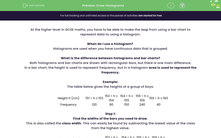At the higher level in GCSE maths, you have to be able to make the leap from using a bar chart to represent data to using a histogram.
When do I use a histogram?
Histograms are used when you have continuous data that is grouped.
What is the difference between histograms and bar charts?
Both histograms and bar charts are drawn with rectangular bars, but there is one main difference.
In a bar chart, the height is used to represent frequency, but in a histogram area is used to represent the frequency.
Example:
The table below gives the heights of a group of boys:
| Height h (cm) | 151 < h ≤ 153 | 153 < h ≤ 154 | 154 < h ≤ 155 | 155 < h ≤ 159 | 159 < h ≤ 160 |
| Frequency | 120 | 90 | 150 | 240 | 40 |
Step 1:
Find the widths of the bars you need to draw.
This is also called the class width. This can easily be found by subtracting the lowest value of the class from the highest value.
| Height h (cm) | 151 < h ≤ 153 | 153 < h ≤ 154 | 154 < h ≤ 155 | 155 < h ≤ 159 | 159 < h ≤ 160 |
| Frequency | 120 | 90 | 150 | 240 | 40 |
| Class Width | 2 | 1 | 1 | 4 | 1 |
Step 2:
Find out how high we need to draw the bars.
We have already said that in a histogram the area of the bar represents the frequency.
We can say that frequency = class width x height of the bar
And this can be rearranged into the equation:
height = frequency ÷ class width
The correct name of the height of the bar in a histogram is the frequency density.
This makes our formula: frequency density = frequency ÷ class width
| Height h (cm) | 151 < h ≤ 153 | 153 < h ≤ 154 | 154 < h ≤ 155 | 155 < h ≤ 159 | 159 < h ≤ 160 |
| Frequency | 120 | 90 | 150 | 240 | 40 |
| Class Width | 2 | 1 | 1 | 4 | 1 |
| Frequency Density | 60 | 90 | 150 | 60 | 40 |
Step 3:
Draw your histogram.
To draw the histogram, we plot the class on the bottom (don't forget to use a continuous scale) and the frequency density up the side:
Let's have a go at some questions.








